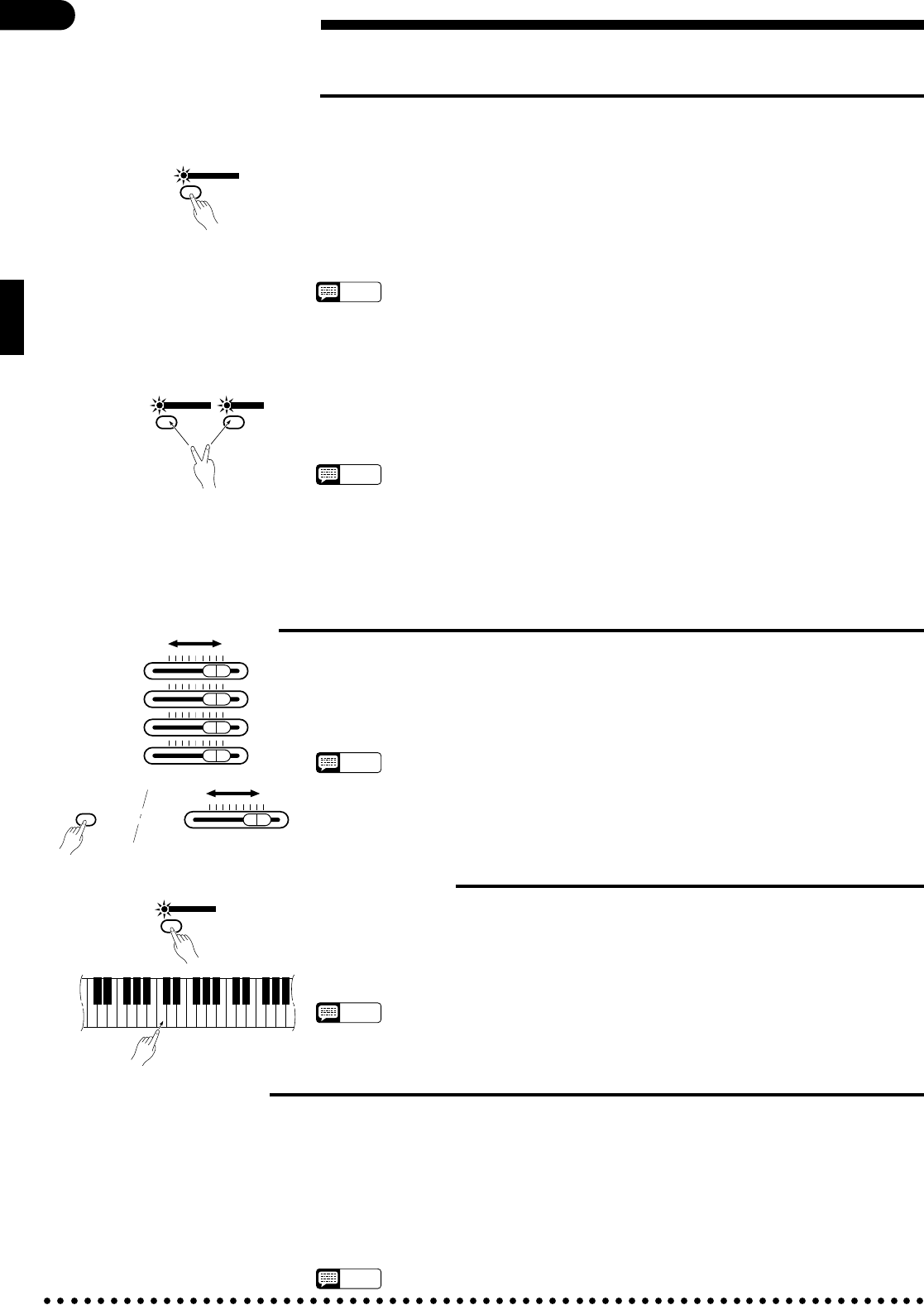
22
■ Full-keyboard ABC
Auto Bass Chord (ABC)
FULL KEYBOARD
When this advanced auto-accompaniment mode is engaged (press the [FULL KEY-
BOARD] button so that its indicator lights) the Clavinova will automatically create ap-
propriate accompaniment while you play just about anything, anywhere on the keyboard:
chords, a bass line, arpeggiated chords, a melody line. You don’t have to worry about
specifying the accompaniment chords. Although Full-keyboard ABC is designed to work
with many songs, some arrangements may not be suitable for use with this feature. Try
playing a few simple songs in the Full-keyboard ABC mode to get a feel for its capabili-
ties.
NOTES
• Chord detection occurs at approximately 8th-note intervals. Extremely short chords —
less than an 8th note in length — may therefore not be detected.
The Conventional Full-keyboard ABC mode can be engaged by pressing the [SIN-
GLE FINGER] and [FINGERED] buttons simultaneously (both indicators will light).
In this mode the split point is de-activated and notes played anywhere on the keyboard
are detected and used to determine the harmonization of the accompaniment. In the Con-
ventional Full-keyboard ABC mode, chord detection is possible when at least three notes
are played anywhere on the keyboard.
● Full-keyboard ABC
● Conventional Full-
keyboard ABC
SINGLE FINGER FINGERED
■ Volume Control
NOTES
• The Dual or SPLIT mode can be used with Full-keyboard ABC.
• The Full-keyboard and Conventional Full-keyboard ABC modes will be disengaged and
the Fingered mode will be engaged if Solo Styleplay is turned on.
• Solo Styleplay will automatically be turned off whenever the Full-keyboard or Conven-
tional Full-keyboard ABC mode is engaged.
• Press the [FULL KEYBOARD] button so that its indicator goes out when you want to exit
from the FULL-KEYBOARD ABC mode. To exit from the Conventional Full-keyboard
ABC mode press the [SINGLE FINGER] or [FINGERED] button twice.
The RHYTHM, CHORD 1, CHORD 2, and BASS volume controls can be used to
adjust the volume of the corresponding accompaniment parts when using ABC. In gen-
eral, CHORD 1 controls rhythmic chords while CHORD 2 controls more decorative
chords (arpeggios, etc.). The volume of the keyboard can be independently controlled by
using the BASS volume control while holding the [MIDI/TRANSPOSE] button.
NOTES
• Some styles may not use all four parts: RHYTHM, CHORD 1, CHORD 2, and BASS.
• Usually the CHORD 1 and CHORD 2 parts will not play simultaneously in the Full-
keyboard ABC mode to prevent possible conflict with the melody. The sound of the
silent part can be restored by changing the setting of the corresponding volume control
— CHORD 1 or CHORD 2.
RHYTHM
CHORD 1
CHORD 2
BASS
MIN MAX
MIN MAX
MIN MAX
MIN MAX
BASS
MIN MAX
MIDI/
TRANSPOSE
■ Changing the ABC Split Point
The ABC split point can be set at any key by pressing the desired key while holding
the [SINGLE FINGER] or [FINGERED] button.
The default split point — F#2 — will always be set automatically whenever the
power is initially turned on.
NOTES
• On the CVP-87A the split point is indicated by the keyboard guide lamp above the split
point key.
SINGLE FINGER
C3
● Mute
■ Special Modes
Some accompaniment notes may be automatically muted if they interfere musically
with what is being played by the right hand. This mute function can be enabled or disa-
bled via the Utility mode “Mute” function described on page 43. The mute function is
normally enabled (default).
When playing a 7th chord in a minor key, the ABC system will automatically shift a 9th
note down to the octave, and a 6th note to the 5th when the “Minor Harmonization” utility
function described on page 43 is turned on. The default setting for this function is off.
NOTES
• Minor Harmonization will not function in the Full-keyboard ABC mode.
● Minor Harmonization


















